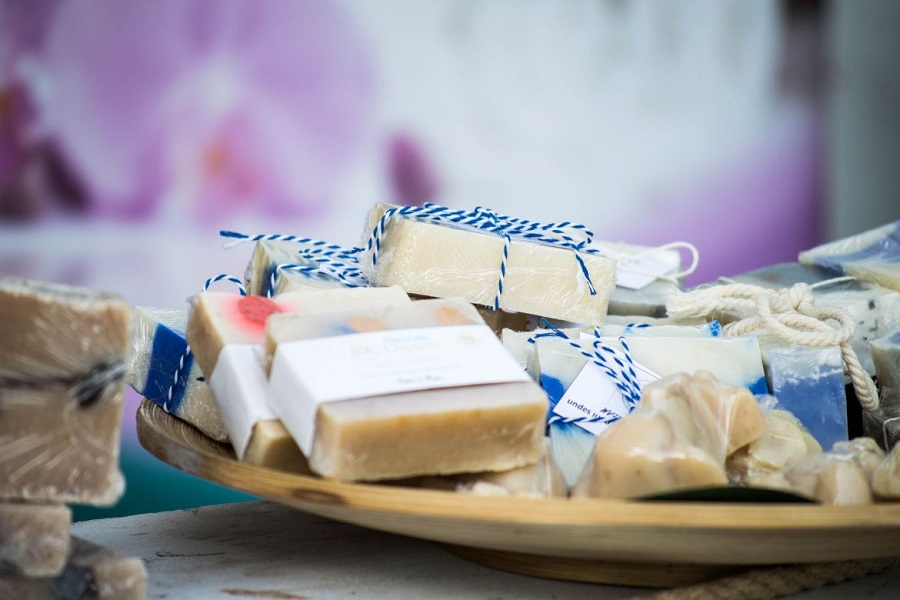Did you know that your skin can absorb nearly 70% of what it comes in contact with? This is a big deal considering there’s a whole network of functions taking place just below the surface, from blood vessels, nerves, glands, and multiple layers of various cells. The skin serves as a barrier to environmental toxins, chemicals, infections, and harsh temperatures, but it still needs support and protection, too.
Our skin goes through several insults on a regular basis, including the use of personal care products, detergents, airborne allergens and toxins, food chemicals, sun exposure, and so on. Unfortunately, there are several chemicals that can be found in the body as a result of using topical care products such as shampoos, lotions, cosmetics, and deodorants. Some of the most commonly used chemicals include parabens, glycol, sulfates, phthalates, and triclosan which have each been linked to hormonal imbalances, increased toxicity, increased risk of infertility, and even an increased risk for cancer. Products containing these chemicals are perhaps doing more harm than good when it comes to your immune system and total body burden (the total accumulation of toxins in the body).
Specifically, parabens are estrogen-mimicking preservatives used widely in cosmetics, also known as xenoestrogens. The CDC has detected parabens in virtually all Americans bodies. According to the European Commission’s Scientific Committee on Consumer Products, longer chain parabens like propyl and butylparaben and their branched counterparts, isopropyl, and isobutyl parabens, “may disrupt the endocrine system and cause reproductive and developmental disorders.” [2]
In the “Fourth National Report on Human Exposure to Environmental Chemicals,” the CDC reported that the average person in the United States has at least 212 chemicals in their blood and urine,” including infants [2]. Some of the most common sources of chemical exposure come from other seemingly inoffensive products such as non-stick coating, fire retardants found on bedding and furniture, baby products, plastic food containers, and other care products.
Avoid These Ingredients
Phthalates
Phthalates are linked to infertility, certain cancers, and other developmental concerns [3]. They’re commonly found in toys, food packaging, curtains, vinyl flooring, raincoats, tap water, detergents, and food packaging, specifically meat and milk packaged with plastic.
Toluene
Toluene is a neurotoxicant and irritant which has been linked to immune system toxicity and certain cancers [3]. One of the most common sources is synthetic fragrances, primarily from perfumes, body sprays, and other products that list “fragrance” as an ingredient. It’s also found in nail polish and paint thinners.
Sodium Lauryl Sulfate (SLS) and Sodium Laureth Sulfate (SLES)
SLS and SLES can cause eye and skin irritation, organ toxicity, endocrine disruption, and increase the risk for certain cancers [3]. Common products containing SLS and SLES include hair color, makeup foundations, liquid hand soaps, bath salts, and toothpastes.
Propylene Glycol
Propylene Glycol is associated with cell damage and kidney and liver disruption. It’s used as a conditioning agent and is frequently found in cosmetics, shampoo, paints, adhesives, enamels, and varnishes.
How to Reduce Your Exposure to Harmful Chemicals
Read ingredient labels
Look for names you’re familiar with, such as plant-based and natural ingredients. Avoid products with a long list of ingredients.
Consider making your own personal care products!
You can find several recipes that include alternatives such as coconut oil and baking soda, both of which are used commonly in DIY products. Check out these homemade recipes (deodorant, lotion, lip balm, makeup, and more) from Keeper of the Home, and you can be certain of what you’re letting come in contact with your skin!
Utilize the EWG
Refer to the Environmental Working Group’s website and mobile app to check the products you use for their safety rating and to search for verified alternatives. You can also use the mobile app to scan the barcode on products you’re wondering about for an instant rating while shopping. The EWG also has a list of tips and toxins to look out for while choosing what products you use.
Promote Natural Detoxification
If the body can’t eliminate optimally and completely, excess toxins can build up in fatty tissues and organs, which poses additional stress on the body.
Eat Well
It’s important to support the body’s natural defenses by eating a variety of organic fruits and vegetables rich in antioxidants and support the immune system by eliminating as many additional stressors as possible, including environmental toxins.
Sweat!
One of the best ways to rid the body of built-up foreign substances is to get moving and get sweating! Sweating, either by exercise, far infrared sauna, or hot baths, is one of the most effective ways to clear toxins. You could also consider an IonCleanse foot bath, which you can discuss further with your Newbridge provider.
Drink plenty of purified water
It’s important to drink clean, purified water that’s still rich in naturally occurring minerals, at least half your body weight in ounces daily (even more with vigorous exercise or increased sweating).
Elimination
Eliminating properly, and daily, is significantly important to prevent reabsorption of toxins the body is trying to clear out. Having daily, complete bowel movements is an essential part of a detoxification lifestyle. Increase water, fiber, and consider increasing magnesium per your provider’s recommendation for optimizing motility.
Relax
Relax deeply every day to get your nervous system in a state of calm, rest, and relaxation. Believe it or not, this is highly important for nearly all functions in the body, including detoxification. Take some time each day to recharge and take a breather from all of life’s demands, and get in touch with your body. Consider meditation, mindfulness practices, yoga, or other meditative activities such as spending time outside or completing a task you thoroughly enjoy.
Resources
1. https://www.ewg.org/skindeep/top-tips-for-safer-products/#.WxmOrUgvyUk
2. https://www.cdc.gov/ExposureReport/
3. https://www.mercola.com/infographics/personal-care-products.htm
4. https://keeperofthehome.org/identifying-avoiding-toxins-beauty-personal-care-products/
5. http://drhyman.com/blog/2010/05/19/is-there-toxic-waste-in-your-body-2/


